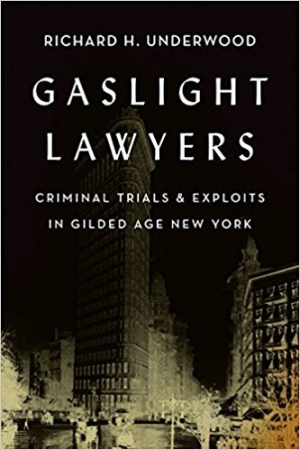Gaslight Lawyers
Criminal Trials and Exploits in Gilded Age New York
- 2017 INDIES Finalist
- Finalist, True Crime (Adult Nonfiction)
The true allure of the book is in its artfully chosen details, taken from sources ranging from court transcripts to personal memoirs.
Richard H. Underwood’s Gaslight Lawyers is an intriguing collection of stories profiling some of New York City’s most influential lawyers of the late nineteenth and early twentieth centuries, as well as their law enforcement counterparts and the diverse set of cases they handled.
In a time when criminal lawyers were elevated to celebrity status, cases were often defined—and their outcomes determined—by the characters at trial, rather than by the nature of the crimes themselves. The time period often referred to as the Gaslight Era was marked by an often corrupt criminal justice system, “when the field of scientific, forensic evidence was only beginning to emerge and when guilt or innocence usually turned on eyewitnesses in testimony.” Throughout the book, this corruption is made abundantly clear.
Gaslight Lawyers is divided into ten chapters, each of which covers either a lawyer’s career or a specific case. Three chapters are devoted to notorious defense attorney William “Big Bill” Howe, the man behind the Hackensack Mad Monster, the Man-Killing Racetrack Girl, and the case of femme fatale Augusta Nack. Prosecutor William “The Reformer” Travers Jerome is the focus of the final chapter, which details his career as a DA known for convicting corrupt attorneys.
Within the book, these attorneys are revered as often as they’re criticized, and despite occasional editorializing, stories are kept objective and in context. The book’s greatest service to the field of true crime is its focus on cases in the grand scheme of criminal justice. It still takes into account the often nefarious ethics of the era, when shady tactics were the norm and smooth-talking defense attorneys swayed entire juries.
The two chapters devoted to “Frenchy,” the killer who was thought to be New York’s Jack the Ripper, are a highlight of the book. The pages are filled with vivid yet conscientious descriptions of the crime scene, with lines like “a gash extended from the base of the spine, carried upward across her abdomen and reaching a point halfway up her right side.” These chapters are flooded with evidence of how much input came from those inside the criminal justice field and also from the media, who sensationalized an already considerable spree of murders.
The book keeps a riveting pace throughout, maintaining interest even in dense, history-packed sections, thanks to accessible language and interpretation. Cases and characters are depicted in rich, anecdotal narrative form, while still providing a comprehensive history of criminal justice.
The true allure of the book is in its artfully chosen details. Combining research ranging from court transcripts to personal memoirs, it reconstructs scenes with the kind of particulars that usually come from firsthand experiences. Fascination with the law and with criminal proceedings imbues the pages, imparting a delightful sense of suspense, even though the book often deals in cases with known outcomes.
Gaslight Lawyers is a comprehensive and compelling addition to the true crime genre, offering a template for balancing characterization with content. Richard H. Underwood’s knowledge of law and order combined with his research into the underbelly of New York City’s Gaslight Era make for an exhilarating, informative read.
Reviewed by
Lillian Brown
Disclosure: This article is not an endorsement, but a review. The publisher of this book provided free copies of the book and paid a small fee to have their book reviewed by a professional reviewer. Foreword Reviews and Clarion Reviews make no guarantee that the publisher will receive a positive review. Foreword Magazine, Inc. is disclosing this in accordance with the Federal Trade Commission’s 16 CFR, Part 255.

